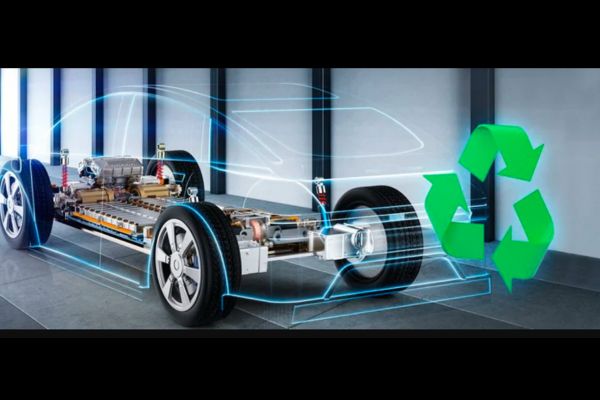The global electric vehicle battery recycling market size is expected to reach around USD 73.18 billion by 2034 from USD 4.81 billion in 2024 with a CAGR of 31.30%.

Electric Vehicle Battery Recycling Market Key Insights
- The lithium-ion battery segment accounts for 46% of the revenue share.
- The lead-acid battery segment holds a significant market share of over 30%.
- By application, electric cars hold a 39% market share.
- The Asia Pacific region holds a sizeable market share of over 46%.
How Is AI Enhancing EV Battery Recycling?
AI is revolutionizing the EV battery recycling process by making it smarter, faster, and more efficient. It plays a crucial role in identifying, sorting, and assessing used batteries for their remaining value.
Using computer vision and machine learning, AI-powered systems can automatically detect battery types, assess their state of health, and determine whether they should be reused, repurposed, or recycled. This reduces manual labour, enhances safety, and increases the speed of the recycling process.
Furthermore, AI helps optimize the entire recycling value chain. It predicts material recovery yields, automates disassembly processes, and guides robotic systems to safely extract valuable materials like lithium, cobalt, and nickel.
AI also aids in creating data-driven strategies for logistics, inventory, and sustainability tracking, enabling companies to meet environmental regulations and improve circular economy outcomes in the EV battery ecosystem.
Market Scope
| Report Coverage | Details |
| Market Size in 2024 | USD 4.81 Billion |
| Market Size by 2034 | USD 73.18 Billion |
| Growth Rate from 2024 to 2034 | CAGR of 31.30% |
| Base Year | 2024 |
| Forecast Period | 2024 to 2034 |
| Segments Covered | Chemistry, Process, Application, End User, and Geography |
Market Drivers:
- Rapid Growth of EV Adoption:
The surge in electric vehicle sales globally is leading to a growing volume of used batteries that require sustainable end-of-life management. - Rising Demand for Battery Materials:
Increasing demand for critical materials like lithium, cobalt, and nickel is pushing the need for efficient recycling to recover and reuse these resources. - Environmental Regulations and Policies:
Governments worldwide are enforcing stricter environmental regulations and extended producer responsibility (EPR) laws to ensure proper battery disposal and recycling. - Declining Raw Material Availability:
Limited reserves and geopolitical risks associated with raw material mining are driving interest in recycling as an alternative source.
Market Opportunities:
- Advancements in Recycling Technologies:
Innovations in hydrometallurgical and direct recycling processes are improving recovery rates and reducing environmental impact. - Integration of AI and Automation:
AI-driven systems are streamlining sorting, disassembly, and material recovery, increasing efficiency and safety in recycling operations. - Second-Life Battery Applications:
Batteries with remaining capacity are being repurposed for stationary energy storage, creating new business models and reducing waste. - Global Shift Toward Circular Economy:
Companies are increasingly adopting circular economy principles, opening new markets for sustainable battery material recovery and reuse.
Market Challenges:
- Complex Battery Design and Lack of Standardization:
Varied chemistries and designs of EV batteries complicate disassembly and recycling processes. - High Initial Investment Costs:
Setting up advanced recycling infrastructure involves significant capital expenditure and regulatory approvals. - Limited Collection and Supply Chain Infrastructure:
Inadequate systems for collecting, transporting, and tracking used EV batteries hinder large-scale recycling. - Safety Risks in Handling Used Batteries:
Improper handling of damaged or degraded batteries can lead to fire, explosion, or environmental hazards.
Regional Outlook of the Electric Vehicle Battery Recycling Market

Asia Pacific
- Market Size: The region accounted for USD 2.45 billion in 2024 and is projected to reach USD 37.69 billion by 2034, growing at a CAGR of 31.40%.
- Key Drivers:
- Rapid industrialization and increasing demand for electric vehicles in countries like China, India, and Japan.
- Strong end-use sector demand, particularly from the automotive industry.
- Technological advancements in battery recycling processes.
Europe
- Market Leadership: Europe dominated the market in 2023 with the highest revenue share.
- Recycling Standards: Stringent European Union regulations mandate recycling efficiency standards for batteries:
- Recovery of 75% for nickel-cadmium batteries.
- Recovery of 65% for lead-acid batteries.
- Recovery of 50% for other chemistries.
- Key Factors:
- High emphasis on sustainability and circular economy practices.
- Increasing EV adoption driven by environmental policies.
North America
- Recycling Efficiency: Lead-acid batteries are recycled at a rate of nearly 100%, with around 99% lead recovery in the U.S.
- Market Drivers:
- Presence of key recyclers such as Call2Recycle, Aqua Metals, Enersys, and Battery Solutions, Inc.
- Rising popularity of electric vehicles and demand for UPS systems in commercial infrastructure.
Latin America
- Growth Potential: Significant market expansion is expected due to foreign investments and large-scale vehicle manufacturing.
- Example: The Cochrane Coal-fired Power Plant in Chile utilizes a lithium-ion battery storage system, highlighting regional advancements.
Middle East & Africa
- Moderate growth is anticipated due to emerging industrialization and gradual adoption of sustainable technologies.
Electric Vehicle Battery Recycling Market Companies
- ACCUREC Recycling GmbH (Germany)
- American Manganese Inc. (Canada)
- Battery Solutions (US)
- Li-Cycle Corp. (Canada)
- G & P Batteries (UK)
- Recupyl (France)
- Retriev Technologies(US)
- Australian Battery Recycling Initiative (Australia)
- Snam S.p.A. (Italy)
- Umicore N.V. (Belgium)













